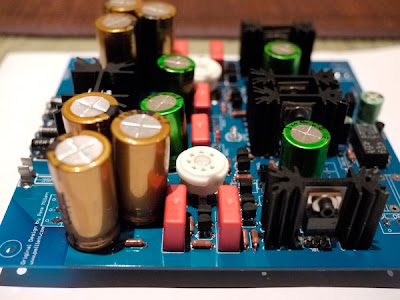For those who have read some previous entries in this blog, you will no doubt have read my ramblings regarding my directly heater triode amp. It began as the 300B story, and thus far, ended at the Electra Print DRD45. Having gained more insight into amp design and building, as well as more reading into the various standard reference books and Internet forums, I have concluded that the 45 is the tube to stay with. Helped in no small part to my 20+ 45 tubes. And in some twisted logic, I still hold that the 45 is a good tube for those wishing to trying different NOS brands and new stock. My reasoning to this; there are good range of NOS 45 available. They are easy to find and readily available on most stores and the price is still the sub US$100 per tube. The globle versions (UX145, UX245, UX345 and UX445) are much more sought after and range in US$150 to US$200 per tube. Whilst expensive they are still readily available. In terms of new production 45, I have only come across the Emission Labs and TJ brands. The range of available 45 is great and the NOS supply is still relatively affordable. This is in contrast to the 300B, 2A3, PX25/60, AD1, 50, 211, 845 and all the other DHT power tubes.
The 45 amp in broad design will be:
- C3g driver tube. Either Triode of Pentode mode. To be reviewed.
- Interstage Coupling. Using 1:1 or near interstage from either Sowter, Lundahl or Tango-ISO.
- Fixed grid bias for 45. Using Tentlabs Negative Bias Module
- Filament heating through Tentlabs filament module for 45.
- Output Transformer is Electra Print 5K with 8R and 16R output. May consider changing to Tamura Amorphous core when the finances allow.
- Passive PSU with 2 choke stages. Using a Lundahl LL1673/140mA common mode choke and an Electra-Print 5532 choke for each channel. All capacitors to be ASC Oil X386 types.
- Rectifier tube 2x6AU4GT.
Most of the parts will be recycled from the DRD45 build that has yet to be done. This will be constructed as a stereo block with no attenuator.
Operating point of the 45 would be at the standard 220V with a -40V bias at 36mA onto a 5K load. Output should be around 1.3W, and will require the driver stage to provide around 40V of swing, or 80Vp-p or 28.4Vrms. If we have a sensitivity of 2Vrms then the driver stage needs to provide a gain of around 15x. An easy task for the C3g. The mu of the C3g is 40, so it might be worthwhile to consider using a 2:1 step-down interstage transformer. This may help reduce the reflected load and increase bandwidth. Being my first self designed amp, the above operating points may be completely wrong. However, it is a start, nonetheless. The other interesting note is that with the gain requirement of the driver stage of 15, it may open up possibilities of using an alternate driver tube, even using another DHT. Nothing ground breaking here.
Below are the heater requirements.
- 45 Tube: 2.5V @ 1.5A = 3.75 W per tube total 7.5 W.
- C3g Tube: 6.3V @ 370mA = 2.33 W per tube total 4.7 W.
- 6AU4GT Tube: 6.3V @ 1.8A = 11.34 W per tube total 22.5 W.
Total Heater consumption = 35 W (approx). More to come later.























